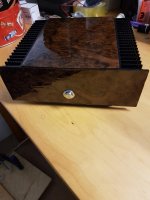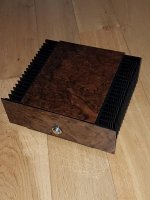So has any one any experience of the 'leading black band' and what it signifies? (If anything!)
5% resistors most often uses the 4 band color code.
1% resistors most often uses the 5 band color code.
The chart in the previous post says it all.
5% resistors most often uses the 4 band color code.
1% resistors most often uses the 5 band color code.
The chart in the previous post says it all.



YES I have it now!
Thanks
I was stuck in the 1950s still...
Now I am confused.
What would be the 5 band color code of a 0.068 ohm resistor? And of a 0.68 ohm one?
What would be the 5 band color code of a 0.068 ohm resistor? And of a 0.68 ohm one?

YES I have it now!
Thanks
I was stuck in the 1950s still...
so..... my resistors have the right values?
Now I am confused:
Resistors waltz on out to six color bands sometimes. The sixth being the temperature coefficient. The fifth being tolerance. Black on the fifth band means it is within 1 percent.
Hi Neel007,
Have you considered that you're amp may be bursting into oscliation when you go beyond a certain voltage bias ? It could be because of your PCB layout. Have you looked at it on a scope ?
Have you considered that you're amp may be bursting into oscliation when you go beyond a certain voltage bias ? It could be because of your PCB layout. Have you looked at it on a scope ?
Now I am confused.
What would be the 5 band color code of a 0.068 ohm resistor? And of a 0.68 ohm one?
I'm not sure that colour banded 0.068 ohm resistors actually exist.
I took a quick look on Mouser and found heaps of SMD resistors at this value. At the time, I spotted just 1 through hole resistor (Vishay) and it had written detail on its outer surface to communicate its spec.
brown is 1%Resistors waltz on out to six color bands sometimes. The sixth being the temperature coefficient. The fifth being tolerance. Black on the fifth band means it is within 1 percent.
black doesn't exist for tolerance (0% tolerance)
Hi Neel007,
Have you considered that you're amp may be bursting into oscliation when you go beyond a certain voltage bias ? It could be because of your PCB layout. Have you looked at it on a scope ?
Hi Mike,
The Amp does not do anything anymore, it acts as a short circuit. What is it in the PCB layout that would prompt you to think of occilation, it is a single layer pcb...
it's just that I have seen cct's burst into oscillation when perameters like voltage bias are adjusted so it is always a possibility that has to be considered. I have some spare ACA boards. If you want to give me the going rate I could post them to you. could be there in a few days.
mike
mike
Measuring-Low-Resistances
This may help.
How to Measure Low Resistances - Robot Room
Mmmm, i see your point. I just checked and ordered the right values, but my simple multimeter can not accurately measure such low values...
This may help.
How to Measure Low Resistances - Robot Room
it's just that I have seen cct's burst into oscillation when perameters like voltage bias are adjusted so it is always a possibility that has to be considered. I have some spare ACA boards. If you want to give me the going rate I could post them to you. could be there in a few days.
mike
Hi Mike,
Thank you, but part of the fun for me is designing and etching my own PCB's. If I go insane before I get it working I might take you up on your offer 😉
Cheers,
Neel
This may help.
How to Measure Low Resistances - Robot Room
Thank you! Very helpful, and I am sure now I have the right resistors!
Cheer,
Neel
Nice Elwood, tell me, when you say mono (I'm still struggling with the concept of mono bridging), do you mean one RCA into each amp, and one speaker into each amp thus creating a "double mono" or stereo or do you mean literally mono audio coming out of both speakers?Here is a pic of my amps, mono operation via single ended cables from my Hafler 915 preamp. Drives Klipsch Heresey 2 speakers, with a Thorens TD 125 Mk2 with an SME 3009 tonearm.
If the latter, I can't see why anyone would want to listen in mono to anything, or am I missing something big here?
Hi, I hope you still think so.Burr Walnut....Sweeeeet!
My marquetry techniques leave a great deal to be desired, but overall I'm fairly satisfied.
Attachments
With no ventilation exhaust on the top cover hot air has nowhere to go. There is no passive convection possible with these enclosures. The temperature inside the box will go pretty high if you leave the amps on for a lengthy amount of time.
With no ventilation exhaust on the top cover hot air has nowhere to go. There is no passive convection possible with these enclosures. The temperature inside the box will go pretty high if you leave the amps on for a lengthy amount of time.
A slow rotating extractor fan at the rear or bottom will fix that.
Unless you used some type of "space glue", (like they attach the tiles to the Space Shuttle with), those are going to peel right off with all the heat the ACA generates. But it does look nice!
Hi, I hope you still think so.
My marquetry techniques leave a great deal to be desired, but overall I'm fairly satisfied.
Semmyroundel, looks nice! What kind of wood did you use?
- Home
- Amplifiers
- Pass Labs
- Amp Camp Amp - ACA

